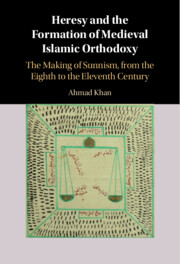 Heresy and the Formation of Medieval Islamic Orthodoxy
Heresy and the Formation of Medieval Islamic Orthodoxy from Part II - Heresy and Society
Published online by Cambridge University Press: 06 April 2023
This chapter makes the case that Abu Hanifa’s relationship to politics and rulers was a key catalyst for the rise of discourses of heresy against him and, perhaps, the most consequential. Abu Hanifa’s alleged involvement with three rebellions flew in the face of a basic tenet of proto-Sunni traditionalist orthodoxy, namely, political quietism. It shows that politics and the state were implicated in evolving conceptions of orthodoxy and heresy, and how the growth of proto-Sunni traditionalism was in some ways fostered by political elites and representatives of the state.
To save this book to your Kindle, first ensure [email protected] is added to your Approved Personal Document E-mail List under your Personal Document Settings on the Manage Your Content and Devices page of your Amazon account. Then enter the ‘name’ part of your Kindle email address below. Find out more about saving to your Kindle.
Note you can select to save to either the @free.kindle.com or @kindle.com variations. ‘@free.kindle.com’ emails are free but can only be saved to your device when it is connected to wi-fi. ‘@kindle.com’ emails can be delivered even when you are not connected to wi-fi, but note that service fees apply.
Find out more about the Kindle Personal Document Service.
To save content items to your account, please confirm that you agree to abide by our usage policies. If this is the first time you use this feature, you will be asked to authorise Cambridge Core to connect with your account. Find out more about saving content to Dropbox.
To save content items to your account, please confirm that you agree to abide by our usage policies. If this is the first time you use this feature, you will be asked to authorise Cambridge Core to connect with your account. Find out more about saving content to Google Drive.